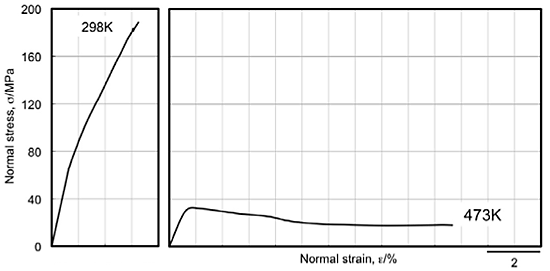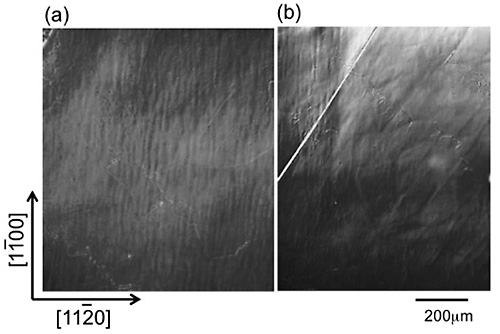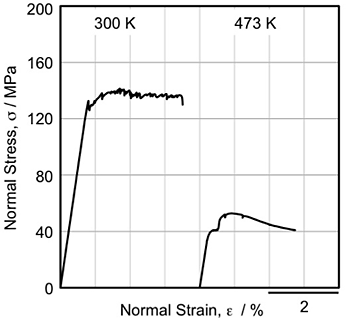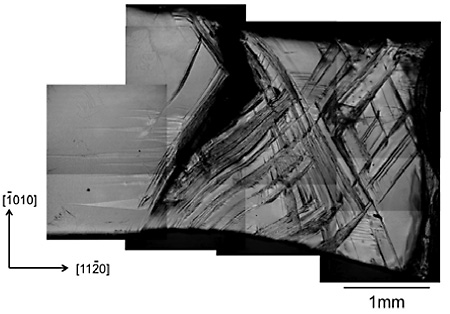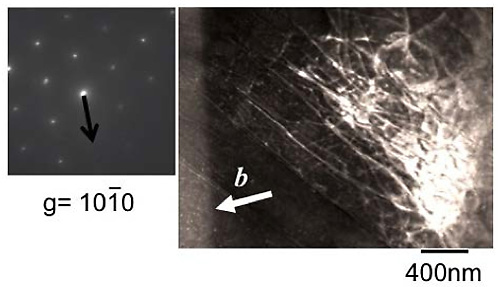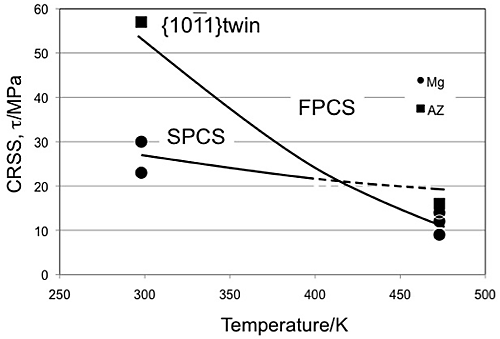It is important to understand the deformation mechanism of yielding in metals to improve their plasticity. In hcp metals, (0001) basal slip and (1010) prismatic slip systems are well known but total number of these independent slip systems is four. According to the von-Mises criterion, another non-basal slip systems must be activated to deform the polycrystalline materials uniformly. It has been reported that {1122}<1123> second order pyramidal slip is activated in magnesium single crystals. Generally, it is known that polycrystalline magnesium shows good ductility over 200![]() . However, the reason of such temperature dependence of ductility is not clear yet. Moreover, in common magnesium alloys, such as AZ31, aluminum and zinc are major alloying elements of them. The effect of aluminum and zinc addition on deformation behavior in magnesium single crystals was reported. In these cases, critical resolved shear stress (CRSS) due to basal slip increased by aluminum addition. We have already reported about non-basal slip in Mg-Li, Mg-Al and Mg-Zn single crystals. However, the effect of aluminum and zinc on non-basal slip in magnesium is not known. From the viewpoint, deformation behavior of pure magnesium and Mg-Al-Zn alloy single crystals above room temperature has been investigated in [1120] tension.
. However, the reason of such temperature dependence of ductility is not clear yet. Moreover, in common magnesium alloys, such as AZ31, aluminum and zinc are major alloying elements of them. The effect of aluminum and zinc addition on deformation behavior in magnesium single crystals was reported. In these cases, critical resolved shear stress (CRSS) due to basal slip increased by aluminum addition. We have already reported about non-basal slip in Mg-Li, Mg-Al and Mg-Zn single crystals. However, the effect of aluminum and zinc on non-basal slip in magnesium is not known. From the viewpoint, deformation behavior of pure magnesium and Mg-Al-Zn alloy single crystals above room temperature has been investigated in [1120] tension.
Mg-Al-Zn alloy single crystal and pure magnesium single crystal were grown by unidirectional solidification method. Two types of specimens in which wide surface are basal and prismatic plane were prepared. Width, thickness and gage length of the both specimen were was 3mm, 0.3mm and 20mm, respectively. Concentration of the Mg-Al-Zn alloy single crystal was estimated by using ICP as Mg-2.6at%Al-0.3at%Zn, this value corresponds to standard of AZ31.
Figure 1 shows typical stress-strain curves of pure magnesium in [1120] tensile at 298K and 473K. At 298K, the specimen yielded at 70MPa and flow stress after yielding increased linearly to 190MPa. In contrast, yield stress of pure magnesium at 473K decreased to 30MPa, and flow stress did not show stain hardening. This result indicates that deformation behavior by non-basal slip change drastically above room temperature.
Figure 2 shows slip bands observed on (0001) basal plane of pure magnesium at 293K. Most of the slip bands on (0001) just after yielding were parallel to [1100], and its correspond {1122}<1123> second order pyramidal (c+a) slip system (SPCS). Another type of slip bands were also found at strain over ~1%. These slip bands corresponded {1011}<1123> first order pyramidal (c+a) slip system (FPCS). In tensile test at 473K, slip bands of FPCS was only observed during tensile deformation. Namely, main non-basal slip system in pure magnesium was different at 298K and 473K.
Figure 3 shows typical stress-strain curves of Mg-Al-Zn alloy single crystals at 298K and 473K. At 298K, while yield stress was increased by aluminum and zinc addition, scarcely strain hardening showed and some serrations were also observed. At 473K, yield stress decreased, as same as the case of pure magnesium, and the stress was higher than that of pure magnesium.
Figure 4 shows (1100) surface of Mg-Al-Zn alloy single crystal deformed at 298K. {1011} twin occurred in this specimen. The twin was observed limited area near end of gage region, and normal strain due to the twin estimated form area fraction of the twin was smaller than whole of tensile strain of specimen. Namely, the alloy single crystal would be deformed by not only {1011} twin but also pyramidal slips.
Figure 5 shows TEM photograph of the alloy deformed at strain of 2.5%. Foil surface was (0001) . Many dislocations parallel to<1120>were observed. By using g![]() b = 0 condition, Burgers vector of most of dislocations were estimated as (c+a), and the dislocations were on {1011} plane. Therefore, the alloy single crystal would be deformed due to FPCS at 473K, as same as pure magnesium.
b = 0 condition, Burgers vector of most of dislocations were estimated as (c+a), and the dislocations were on {1011} plane. Therefore, the alloy single crystal would be deformed due to FPCS at 473K, as same as pure magnesium.
Figure 6 shows CRSS of SPCS, FPCS and {1011} twin obtained in this study. At 298K, SPCS is dominant non-basal slip in pure magnesium. The CRSS would be increased by aluminum and zinc addition. CRSS of FPCS in pure magnesium will be 50 ![]() 60 MPa from slip band observation. CRSS of {1011} twin in pure magnesium may be much higher than 60MPa since the twin didn't observe in this study. On the other hand, {1011} twin was activated in Mg-Al-Zn alloy, and the CRSS could be estimated as 58MPa. CRSS of the twin, therefore, would be decreased by aluminum and zinc addition. At 473K, both single crystals were yielded due to FPCS, and they were decreased drastically. Since ductility due to FPCS was higher than SPCS at 298K, we conclude that enhanced ductility of poly crystalline magnesium and magnesium alloys will be caused by activation of FPCS.
60 MPa from slip band observation. CRSS of {1011} twin in pure magnesium may be much higher than 60MPa since the twin didn't observe in this study. On the other hand, {1011} twin was activated in Mg-Al-Zn alloy, and the CRSS could be estimated as 58MPa. CRSS of the twin, therefore, would be decreased by aluminum and zinc addition. At 473K, both single crystals were yielded due to FPCS, and they were decreased drastically. Since ductility due to FPCS was higher than SPCS at 298K, we conclude that enhanced ductility of poly crystalline magnesium and magnesium alloys will be caused by activation of FPCS.
